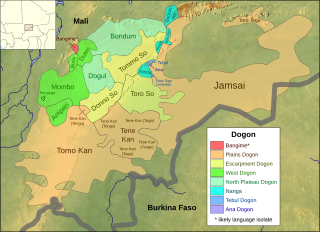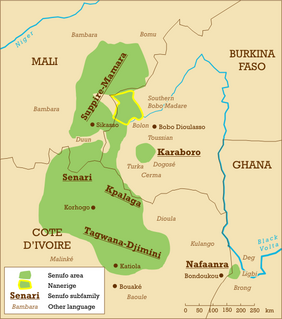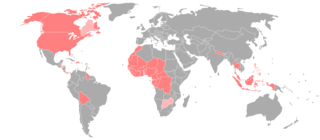 W
WBurkina Faso is a multilingual country. An estimated 70 languages are spoken there, of which about 66 are indigenous. The Mossi language is spoken by about 52.5% of the population, mainly in the central region around the capital, Ouagadougou. French is the official language. English is very rarely spoken.
 W
WBissa, is the language spoken by the Bissa people, a Mande ethnic group of south-central Burkina Faso, northeastern Ghana, northwestern Nigeria, the northernmost tip of Togo and northern Benin. Alternate names for this language include Busansi which is used by the Mossi people or Busa which is used in Nigeria.
 W
WBobo is a major Mande language of Burkina Faso; the western city of Bobo Dioulasso is named partly for the Bobo people. Bobo consists of:Southern dialects: Syabéré (Sya), Benge, Sogokiré, Voré, Zara Northern a.k.a.Bobo de familia
 W
WDagaare is the maternal language of the Dagaaba people in Ghana and Burkina Faso. It has been described as a dialect continuum that also includes Waale and Birifor.
 W
WDyula is a language of the Mande language family spoken in Burkina Faso, Ivory Coast and Mali. It is one of the Manding languages and is most closely related to Bambara, being mutually intelligible with Bambara as well as Malinke. It is a trade language in West Africa and is spoken by millions of people, either as a first or second language. Like the other Mande languages, it uses tones. It may be written in the Latin, Arabic or N'Ko scripts.
 W
WThe Dogon languages are a small closely-related language family that is spoken by the Dogon people of Mali and may belong to the proposed Niger–Congo family. There are about 600,000 speakers of its dozen languages. They are tonal languages, and most, like Dogul, have two tones, but some, like Donno So, have three. Their basic word order is subject–object–verb.
 W
WFrench is a Romance language of the Indo-European family. It descended from the Vulgar Latin of the Roman Empire, as did all Romance languages. French evolved from Gallo-Romance, the Latin spoken in Gaul, and more specifically in Northern Gaul. Its closest relatives are the other langues d'oïl—languages historically spoken in northern France and in southern Belgium, which French (Francien) largely supplanted. French was also influenced by native Celtic languages of Northern Roman Gaul like Gallia Belgica and by the (Germanic) Frankish language of the post-Roman Frankish invaders. Today, owing to France's past overseas expansion, there are numerous French-based creole languages, most notably Haitian Creole. A French-speaking person or nation may be referred to as Francophone in both English and French.
 W
WFula, also known as Fulani or Fulah, is a Senegambian language spoken by more than 65 million people as a set of various dialects in a continuum that stretches across some 20 countries in West and Central Africa. Along with other related languages such as Serer and Wolof, it belongs to the Senegambian branch within the Niger–Congo family, which does not have tones, unlike most other Niger–Congo languages. More broadly, it belongs to the Atlantic geographic grouping within Niger–Congo. It is spoken as a first language by the Fula people from the Senegambia region and Guinea to Cameroon, Nigeria, and Sudan and by related groups such as the Toucouleur people in the Senegal River Valley. It is also spoken as a second language by various peoples in the region, such as the Kirdi of northern Cameroon and northeastern Nigeria.
 W
WHausa is a Chadic language spoken by the Hausa people, mainly within the northern half of Nigeria and the southern half of Niger, and with significant minorities in Chad, Benin, and Cameroon.
 W
WHumburi Senni, or Central Songhay, is a variety of Southern Songhai spoken in the Hombori region, straddling the Burkina–Mali border.
 W
WThe Karaboro languages are spoken in Burkina Faso by approximately 65,000 people. They belong to the Senufo subfamily, but are separated from other Senufo languages by a small band of unrelated languages. Within Senufo they are thought to be most closely related to the Senari languages.
 W
WLobi is a Gur language of Burkina Faso, Ivory Coast and Ghana.
 W
WThe Mossi language is a Gur language of the Oti–Volta branch and one of two official regional languages of Burkina Faso, closely related to the Frafra language spoken just across the border in the northern half of Ghana and less-closely to Dagbani and Mampruli farther south. It is the language of the Mossi people, spoken by approximately 5 million people in Burkina Faso, plus another 60,000+ in Mali and Togo.
 W
WNanerige is a Senufo language spoken in south-western Burkina Faso.
 W
WSamo is a dialect cluster of Niger-Congo languages spoken in Burkina Faso.
 W
WTagwana–Djimini are a branch of the Senufo languages of Burkina Faso.
 W
WAmerican Sign Language (ASL) developed in the United States and Canada, but has spread around the world. Local varieties have developed in many countries, but there is little research on which should be considered dialects of ASL and which have diverged to the point of being distinct languages.